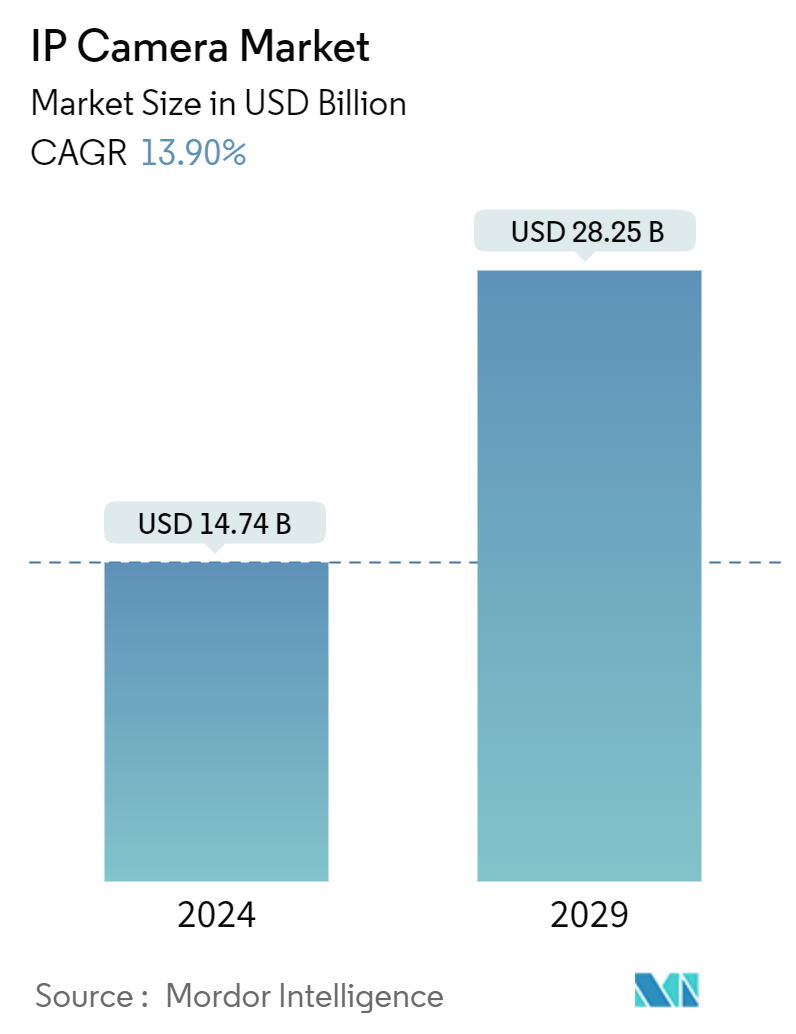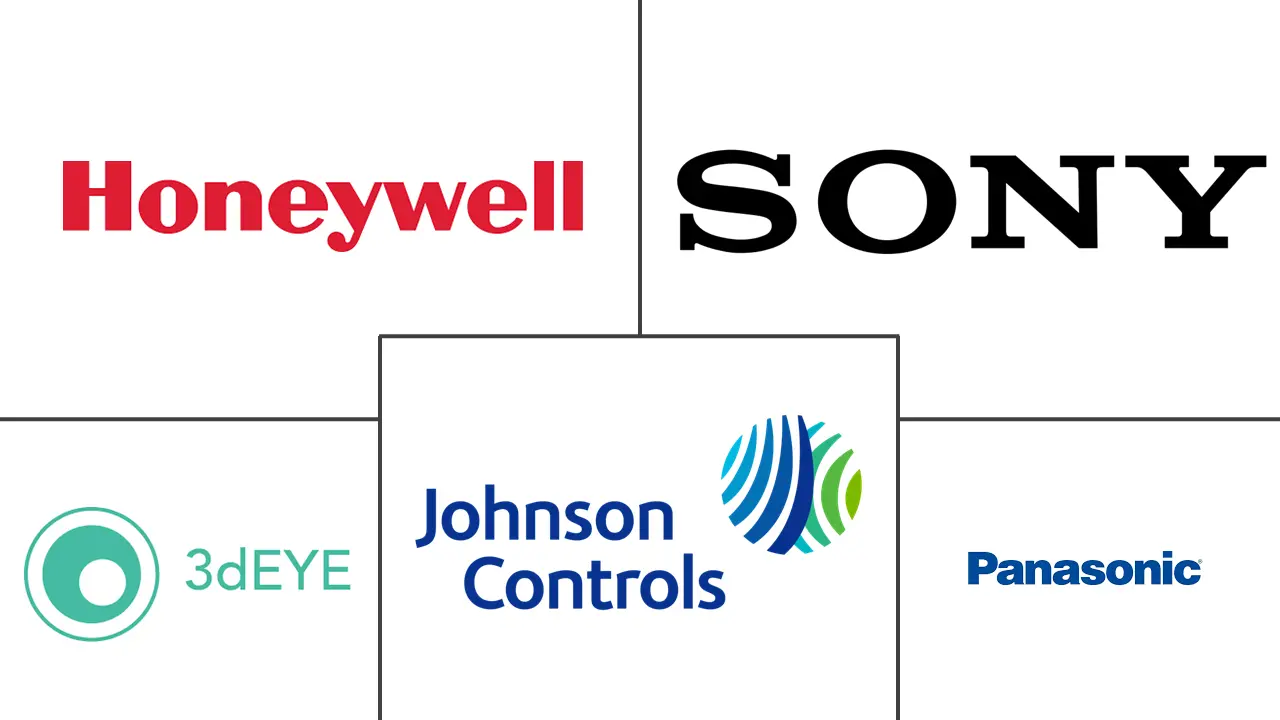Market Size of IP Camera Industry

| Study Period | 2018 - 2029 |
| Market Size (2024) | USD 14.74 Billion |
| Market Size (2029) | USD 28.25 Billion |
| CAGR (2024 - 2029) | 13.90 % |
| Fastest Growing Market | Asia Pacific |
| Largest Market | North America |
| Market Concentration | Low |
Major Players
*Disclaimer: Major Players sorted in no particular order |
IP Camera Market Analysis
The IP Camera Market size is estimated at USD 14.74 billion in 2024, and is expected to reach USD 28.25 billion by 2029, growing at a CAGR of 13.90% during the forecast period (2024-2029).
• An IP camera, or internet protocol camera, is a digital security camera that receives and sends video footage via an IP network. Unlike analog closed-circuit television cameras, IP cameras do not need a local recording device, only a local network. Each IP camera is equipped with a processing chip that compresses the video footage as it is recorded. The higher the resolution of the camera, the more data each video recording contains, which requires more storage space and bandwidth for transmission.
• IP cameras boast superior image quality, offering high-resolution videos and images. The use of digital technology allows for better clarity, sharpness, and color accuracy, enabling effective identification and analysis of events. High-definition (HD) and ultra-high-definition (UHD) resolutions ensure that crucial details are captured, enhancing surveillance capabilities. By connecting to the internet, users can view real-time footage from any location using a smartphone, tablet, or computer. Remote access facilitates immediate response to emergencies, allowing users to take appropriate action or notify authorities when necessary.
• The increasing demand for high-resolution video surveillance is a prominent market driver for IP cameras. As organizations and individuals prioritize safety and security, there is a growing need to capture clear and detailed images to enhance situational awareness. IP cameras, with their ability to provide high-resolution video footage, satisfy this demand by enabling better identification of individuals, objects, and events. This is particularly beneficial in critical applications such as airports, banks, and government institutions where accurate identification is vital.
• Unlike analog cameras that require complex wiring, IP cameras utilize existing network infrastructure, making installation simpler and more cost-effective. With Power over Ethernet (PoE) technology, a single cable can transmit both power and data, eliminating the need for separate power supplies. Additionally, IP cameras offer scalability, allowing for easy expansion of the surveillance system as needs evolve.
• However, high initial installation costs pose a challenge for budget-conscious consumers and businesses. Additionally, interoperability issues between different camera brands and software platforms limit seamless integration and compatibility.
• Further, the conflict between Russia and Ukraine will significantly impact the electronics and semiconductor industry. The conflict has already exacerbated the electronics and semiconductor supply chain issues and chip shortages that have affected the industry for some time. The disruption may result in volatile pricing for critical raw materials such as nickel, palladium, copper, titanium, and aluminum, resulting in material shortages. This, in turn, could impact the manufacturing of IP cameras.
IP Camera Industry Segmentation
We have tracked the revenue generated from selling IP cameras offered by different market players for various applications for market estimation. The market trends are evaluated by analyzing significant market players' investments in product innovation, diversification, and expansion efforts. Further, the advancements in image quality, video analytics, connectivity, artificial intelligence & machine learning algorithms, and advancements in cybersecurity are also crucial in determining the growth of the studied market.
The IP camera market is segmented by type (fixed, Pan-Tilt-Zoom (PTZ), and Varifocal), end-user industry (residential, commercial, industrial, government, and law enforcement), geography (North America, Europe, Asia-Pacific, Latin America, and the Middle East and Africa). The market sizes and forecasts are provided in terms of value (USD) for all the Above Segments.
| By Type | |
| Fixed | |
| Pan-Tilt-Zoom (PTZ) | |
| Varifocal |
| By End-user Industry | |
| Residential | |
| Commercial (BFSI, Education, Healthcare, Real Estate, Retail, and others) | |
| Industrial | |
| Government and law enforcement |
| By Geography*** | |
| North America | |
| Europe | |
| Asia | |
| Latin America | |
| Middle East and Africa | |
| Australia and New Zealand |
IP Camera Market Size Summary
The IP camera market is poised for significant growth, driven by the increasing demand for high-resolution video surveillance and the need for advanced security solutions across various sectors. IP cameras, which utilize internet protocol networks for video transmission, offer superior image quality and remote access capabilities, making them ideal for applications in critical areas such as airports, banks, and government institutions. The shift from analog to digital technology has simplified installation processes and reduced costs, as IP cameras can leverage existing network infrastructure. However, challenges such as high initial costs and interoperability issues between different brands and software platforms remain. The ongoing geopolitical tensions, particularly the conflict between Russia and Ukraine, have also impacted the electronics and semiconductor supply chains, potentially affecting the availability and pricing of materials essential for IP camera manufacturing.
The market is experiencing robust expansion, particularly in the Asia-Pacific region, where rapid urbanization and increasing security concerns are driving demand. The integration of artificial intelligence and advanced analytics with IP camera technology is enhancing surveillance capabilities, offering features like facial recognition and behavior analysis. The retail and BFSI sectors are increasingly adopting IP cameras for security and operational efficiency, while cloud-based solutions are providing scalable and cost-effective storage options. Innovations such as wide dynamic range technology and low-light performance are addressing challenges in diverse lighting conditions. The market is characterized by fragmentation, with key players investing in research and development, strategic collaborations, and product launches to meet evolving consumer demands and capitalize on emerging opportunities.
IP Camera Market Size - Table of Contents
-
1. MARKET INSIGHTS
-
1.1 Market Overview
-
1.2 Industry Attractiveness - Porter's Five Forces Analysis
-
1.2.1 Threat of New Entrants
-
1.2.2 Bargaining Power of Consumers
-
1.2.3 Bargaining Power of Suppliers
-
1.2.4 Threat of Substitute Products
-
1.2.5 Intensity of Competitive Rivalry
-
-
1.3 Industry Value Chain Analysis
-
1.4 Technological Advancements
-
1.5 Impact of COVID-19 and Macro Economic Trends on the Industry
-
-
2. MARKET SEGMENTATION
-
2.1 By Type
-
2.1.1 Fixed
-
2.1.2 Pan-Tilt-Zoom (PTZ)
-
2.1.3 Varifocal
-
-
2.2 By End-user Industry
-
2.2.1 Residential
-
2.2.2 Commercial (BFSI, Education, Healthcare, Real Estate, Retail, and others)
-
2.2.3 Industrial
-
2.2.4 Government and law enforcement
-
-
2.3 By Geography***
-
2.3.1 North America
-
2.3.2 Europe
-
2.3.3 Asia
-
2.3.4 Latin America
-
2.3.5 Middle East and Africa
-
2.3.6 Australia and New Zealand
-
-
IP Camera Market Size FAQs
How big is the IP Camera Market?
The IP Camera Market size is expected to reach USD 14.74 billion in 2024 and grow at a CAGR of 13.90% to reach USD 28.25 billion by 2029.
What is the current IP Camera Market size?
In 2024, the IP Camera Market size is expected to reach USD 14.74 billion.

